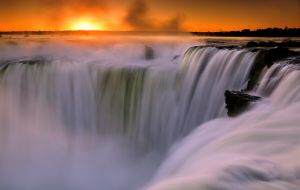MercoPress. South Atlantic News Agency
Iguazu Falls chosen as one of the natural seven wonders of the world
 The majestic Devil’s Throat attracts thousands of tourists every year
The majestic Devil’s Throat attracts thousands of tourists every year The Iguazú Falls located on the border of Argentina and Brazi and consisting of approximately 257 individual falls over 2.7 kilometres were chosen as one of the new natural seven wonders of the world in a contest in which thousands of people voted via text messages, by phone and online. The result will be made official in 2012 with a big celebration.
The Garganta del Diablo (Devil’s throat) with its U-shape is undoubtedly the highlight of these majestic waterfalls. It is 82 metres high, 150 metres wide and 700 metres long, while the rest of the falls average 64 metres.
Iguazú (Bing River, in Guarani) Falls has long been one of Argentina and Brazil’s most popular touristic destinations. Over 2000 species of plants, 400 of birds and 70 mammals have been registered in the area.
The new seven wonders stemmed of the voting of 28 final candidates, chosen by a group of experts after analyzing over 450 bids. Voting ended on Friday November 11th 2011 at 11.11, and 11 seconds.
During a press conference to celebrate the election, Argentine Misiones province Governor Maurice Closs assured that the Iguazú Falls are “one of the world’s seven natural wonders” adding that the “the committee has sent us the provisional vote” that will be confirmed next year, and “sent us a certificate which stated that we are one of the new seven natural wonders”.
Closs explained that result will be made official early in 2012 with a big celebration. Likewise, he said that the celebrations will take place in the Iguazú Falls, in Buenos Aires and in Brasilia.
Alongside the Iguazú Falls, the Amazon River, Halong Bay in Vietnam, South Africa’s Mesa Mountain, the subterranean river in Puerto Princesa, Phillipines, Jeju Island in South Corea and Komodo, Indonesia also made the cut.
The Ha-Long bay is located at the Northern Province of Vietnam, Quang Ninh, and has 120 kilometres along the coastline and a water extension of over 1,500 kilometres. The bay has a dense collection of 1,969 islands of different forms and sizes.
Many of these islands have enormous caves, lakes and beaches. Another characteristic of the area is its wildlife that includes 200 species of fishes and 450 different species of molluscs.
The Amazon Rainforest covers 5,500,000 sq km of the 7 million sq km of the Amazon forests. It represents more than half of the tropical forest remaining in the world, and has the greatest collection of plant and animal life. The Amazon Rainforest covers the majority of the Amazon Basin and the high temperatures of the area are favourable for its biodiversity.
The volume of the Amazon River is the largest of the world and it’s the largest basin of the planet.
The Puerto Princesa Subterranean River is located at 50km north to the Puerto Princesa City in the Philippine Palawan Island. One of the main characteristics of this river is that it travels through a cave with stalactites, stalagmites, and many large chambers and then flows into the South China Sea.
The Komodo National Park is formed by three large islands: Komodo, Rinca and Padar, and also smaller ones, for a total area of 1,817 sq km.
The park located in Indonesia was founded in 1980 aimed to protect the Komodo Dragon (Varanus komodoensis) and other species of plants and animals. The origin of the Islands of the national park is volcanic.
The Jeju Island is a volcanic island located 130km to the South of Korea. Jeju is the smaller province and largest island of South Korea; it has a surface area of 1,846 sq km.
The island’s main feature is the Hallasan, the tallest mountain in South Korea, and it has 360 satellite volcanoes around it.
The Table Mountain is one of the icons of South Africa and the only natural place in the world that receives its name from a constellation of stars: Mensa, meaning table. The flat top of the mountain has resisted the erosion during six million years and hosts the smallest but richest floral kingdom of the world with over 1,470 floral species.
The Mountain also has in impressive selection of wildlife with numerous endangered species.




Top Comments
Disclaimer & comment rules-

-

-

Read all commentsA wonderful place.
Nov 12th, 2011 - 06:02 pm 0“The new natural seven wonders of the world”
Nov 12th, 2011 - 06:03 pm 0It's surprising how blinkered we are to THE greatest natural wonder of this world.
Look around the observed planets of our Solar System, of other systems, of the galaxy, and, by extrapolation, the universe.
Beings from the vast distances of space will look at the earth and their jaws will drop in awe at this planet that has . . . . . a vast blue ocean.
it looks very nice indeed,
Nov 12th, 2011 - 06:14 pm 0not as impressive as the water fall in my garden, but impressive just the same .lol
Commenting for this story is now closed.
If you have a Facebook account, become a fan and comment on our Facebook Page!